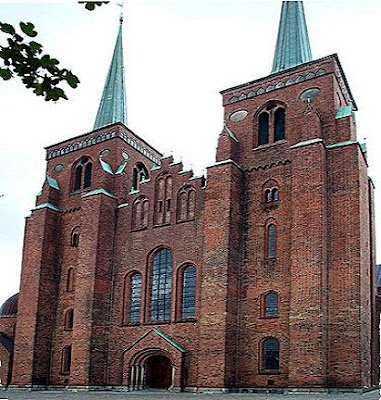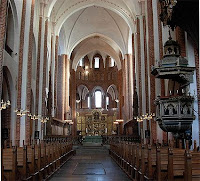Roskilde Cathedral is a cathedral in the city of Roskilde on Island of Zealand in eastern Denmark. It was the first Gothic cathedral to be built of brick and its construction encouraged the spread of this Brick Gothic style throughout Northern Europe which was built during 12th and 13th centuries and incorporates both Gothic and Romanesque architectural features in its design. It was the only cathedral in Zealand until the 20th century. The details of Roskilde Cathedral are explained in world tour guides below.
 Roskilde Cathedral has been the main burial site for Danish monarchs since the 15th century. As such, it has been significantly extended and altered over time as individual rulers have added multiple burial chapels. Following the Reformation in 1536 the Bishops residence was moved to Copenhagen, and he from then on held the title Bishop of Zealand. Royal coronations normally took place in Copenhagens Church of Our Lady or the chapel of Frederiksborg Palace. It is a major tourist attraction bringing in over 125,000 visitors annually. Since 1995 the cathedral has been listed as a UNESCO World Heritage Site.
Roskilde Cathedral has been the main burial site for Danish monarchs since the 15th century. As such, it has been significantly extended and altered over time as individual rulers have added multiple burial chapels. Following the Reformation in 1536 the Bishops residence was moved to Copenhagen, and he from then on held the title Bishop of Zealand. Royal coronations normally took place in Copenhagens Church of Our Lady or the chapel of Frederiksborg Palace. It is a major tourist attraction bringing in over 125,000 visitors annually. Since 1995 the cathedral has been listed as a UNESCO World Heritage Site.The cathedral has been the home of one of Denmark leading boys choirs, the Roskilde Cathedral Boys Choir. The choir soon celebrating its 20th birthday is a key resource in the parish youth work. All choristers go to normal school but meet up 2-3 times a week to rehearse. Every second year the choir travels abroad destinations being as different as New Zealand, Scandinavia, England, Greenland, France and Canada. Roskilde was named as the new capital of Denmark by King Harald Bluetooth about the year 960. A small timber church was built there and dedicated to the Holy Trinity. King Harald was buried inside the little church at Roskilde but no trace of it has ever been located.
In about 991 Roskilde was made seat of Bishop of Roskilde under supervision of Archbishop of Hamburg, who had responsibility for converting pagan kingdoms of Scandinavia. The bishop was responsible for island of Zealand, Scania, and islands to south including Rugen off coast of northern Germany. The church was built in Romanesque style with half rounded interior arches to support the flat interior ceiling. A three sided stone monastery was constructed adjoining cathedral on north side for monks and others associated with cathedral. Bishop Svend succeeded in bringing an important relic, skull of St. Lucius, an early pope, who became patron saint of the cathedral. The skull is now located in Catholic Cathedral of St. Ansgar in Copenhagen.
Bishop Jacob Erlandsen built a school at cathedral for education of poor children in 1249. In 1310 a Lady Chapel was added onto cathedral of present mausoleum which houses tombs of many of Denmarks recent royal family. Bishop Peder Jensen Lodehat forcibly removed body of Queen Margrethe I from Soro Abbey in 1414 and interred her with great pomp inside cathedral. In 1439 work began on interior of cathedral, proceeding as far as the choir. But on 14 May 1443 a terrible fire swept through city and burned cathedral. It was damaged so severely that it was not rededicated until 1464, built in footprint of earlier building. King Christian I paid for addition of a new Chapel of Three Kings as part of overall reconstruction.

 The cathedral was last bastion of Catholicism in Sjaelland but in 1536 Lutheran Superintendent of Zealand moved to Copenhagen, although Roskilde was still officially cathedral. The decline of Roskilde was precipitous, all the monasteries, church schools, chapter houses, were closed and property snapped up by crown or local noble families. The cathedrals gigantic crucifix and other Catholic symbols were taken down or destroyed. Because the church was a royal resting place, the cathedral was spared the savage looting of churches that accompanied the Reformation in other parts of the country. Superintendents quickly were titled bishops again and Bishop of Zealand continued to live and work from Copenhagen until Zealand Diocese was split from Copenhagen in 1920s.
The cathedral was last bastion of Catholicism in Sjaelland but in 1536 Lutheran Superintendent of Zealand moved to Copenhagen, although Roskilde was still officially cathedral. The decline of Roskilde was precipitous, all the monasteries, church schools, chapter houses, were closed and property snapped up by crown or local noble families. The cathedrals gigantic crucifix and other Catholic symbols were taken down or destroyed. Because the church was a royal resting place, the cathedral was spared the savage looting of churches that accompanied the Reformation in other parts of the country. Superintendents quickly were titled bishops again and Bishop of Zealand continued to live and work from Copenhagen until Zealand Diocese was split from Copenhagen in 1920s.In 1635-6 two west towers were raised and given now familiar tall thin spires clad in copper. The towers house six bells. The oldest surviving bell was cast in 1508 by Hans Jensen. Johannes Fastenowe cast two bells in 1511 paid for by Bishop Johan Ravensberg. The largest bell Stormklokken hangs in the north tower. Burchado cast a bell in 1594 that hangs with the Jensen and smaller Fastenowe bell in the south tower. A magnificent Royal Door on the west front was carved by Geert Barchmann. The new portal was used only on state occasions visitors enter by the south door. The beautiful entrance was later moved to Holmen Church in Copenhagen. In 1645 Zealand's bishop ordered the recording of all baptism, marriages, and deaths throughout Zealand and many of Denmark's earliest vital records exist as a result.
Post Title
→Roskilde Cathedral
Post URL
→https://guidice-galleries.blogspot.com/2010/08/roskilde-cathedral.html
Visit guidice galleries for Daily Updated Wedding Dresses Collection








